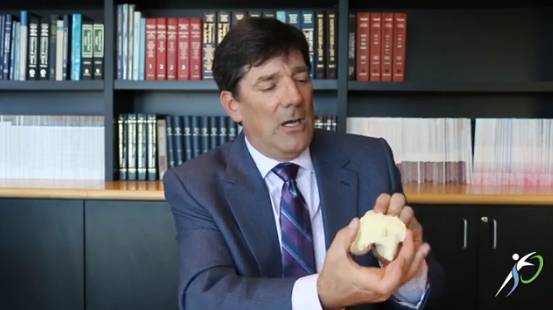- What is Total Knee Replacement?
- What is the Preparation Process for Total Knee Replacement?
- How is the Total Knee Replacement Plan Executed?
- What Are the Benefits of Total Knee Replacement?
For patients who experience pain and loss of function in the knee, and who have not found relief from conservative treatment methods, a total knee replacement (also known as total knee arthroplasty) may be an option to cure pain and restore normal function; but how is a total knee replacement surgery performed?
Scott M. Desman, M.D., F.A.A.O.S., a board-certified orthopaedic surgeon specializing in joint replacement surgery at South Florida Orthopaedics & Sports Medicine, has perfected total knee replacement over the years by using patient-specific instrumentation and computer assistance. “The goal of a total knee replacement is to replace the surfaces of the knee,” says Dr. Desman,
“The goal of a total knee replacement is to replace the surfaces of the knee,” says Dr. Desman,
“The job of the surgeon is to make sure that the implant is put in perfectly straight. Using computer assistance, we preoperatively plan the surgery on a computer model of the patient’s knee and then execute the plan at the time of surgery. This gives a perfect result consistently every time, to give the patient the best result possible.”
What is Total Knee Replacement?
Roughly 700,000 total knee replacement surgeries are performed every year. As the population ages, that number is expected to increase significantly in the next ten to fifteen years. During a total knee arthroplasty, state-of-the-art tools made of metal and specially-designed plastic are used to replace the damaged bone and cartilage of the knee.
A total knee replacement can typically be broken down into four stages:
- Preparing the bone and taking out the damaged cartilage
- Positioning the metal implants and reforming the structure of the knee joint
- Resurfacing of the kneecap with a specially-designed plastic button placed behind the patella
- Placing a plastic spacer between the metal components to establish a fluid surface that allows the joint to move freely
What is the Preparation Process for Total Knee Replacement?
Before operating, Dr. Desman and his team map out exactly what will be done to the knee using state-of-the-art technology and three-dimensional modeling.
“To execute a computer-assisted patient specific plan, we first do either a CT scan or an MRI of the patient’s knee,” says Dr. Desman. “This allows us to create a three dimensional model of the patient’s knee on a computer.”
“The whole procedure is done on a computer before any surgery is performed. We place the implants precisely the way we want them to be at the end of the surgery. And the computer generates a 3D printer model of what we call a cutting block.”
How is the Total Knee Replacement Plan Executed?
Following the computer imaging process, a 3D model of the patient’s knee is created, including the lower end of the thigh bone (femur) and the upper end of the shin bone (tibia). From this model, a 3D cutting block is designed and constructed to be used during surgery.
“In surgery, that plastic cutting block would fit on the patient’s femur bone in a very specific way,” says Dr. Desman. “It just locks on; you can only put it in one way. The block has little holes that we put pins in to secure. Once secured and precisely aligned, we’re able to use the saw blade to give us the exact cut of the femur that we planned preoperatively.”
“The tibia has a similar cutting device,” Dr. Desman continues. “We use that piece in surgery, and it fits precisely on the patient’s bone, again locked in with pins through tiny holes in the implant. A slot on the device allows the saw blade to go through it and cut the bone in an exact way to make sure it’s perfectly straight. By making these cuts very straight, all the guesstimates of manual surgery are removed.”
What Are the Benefits of Total Knee Replacement?
According to the American Academy of Orthopedic Surgeons, 90% of patients who undergo a total knee arthroplasty report considerably less pain afterward. Studies also show that 85% of artificial knees continue to function well after twenty years. The components’ longevity plays a major role in the procedure’s popularity. After about six weeks, most patients can walk comfortably with minimal support, and after muscle strength is reestablished, patients can enjoy most daily activities again.
“The results are that the cuts are perfect,” says Dr. Desman. “And for the femur, we don’t have to drill a hole in the bone to line it up the way we normally would do. And this reduces bleeding, reduces pain, and improves the patient’s recovery.”
If you have any questions or would like to learn more about total knee replacement, please feel free to contact us.
